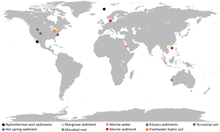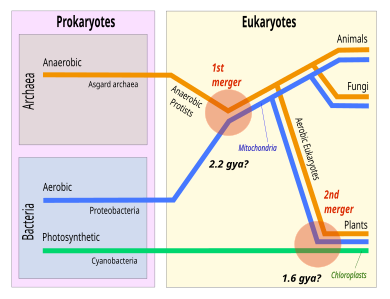Asgard (archaea)
| Asgard | |
|---|---|
| Scientific classification | |
| Domain: | Archaea |
| Kingdom: | Proteoarchaeota |
| Superphylum: | Asgard Katarzyna Zaremba-Niedzwiedzka, et al. 2017 |
| Phyla | |
|
see text | |

| |
| Synonyms | |
| |
Asgard or Asgardarchaeota
Discovery and nomenclature
In the summer of 2010, sediments were analysed from a gravity
In 2016, a University of Texas-led team discovered Thorarchaeota from samples taken from the White Oak River in North Carolina, named in reference to Thor, another Norse god.[14] Samples from Loki's Castle, Yellowstone National Park, Aarhus Bay, an aquifer near the Colorado River, New Zealand's Radiata Pool, hydrothermal vents near Taketomi Island, Japan, and the White Oak River estuary in the United States contained Odinarchaeota and Heimdallarchaeota;[3] following the Norse deity naming convention, these groups were named for Odin and Heimdall respectively. Researchers therefore named the superphylum containing these microbes "Asgard", after the home of the gods in Norse mythology.[3] Two Lokiarchaeota specimens have been cultured, enabling a detailed insight into their morphology.[15]
Description
Proteins
Asgard members encode many eukaryotic signature proteins, including novel
Asgard archaeons have a regulated
Metabolism
-
Metabolic pathways of Asgard archaea, varying by phyla[22]
-
Metabolic pathways of Asgard archaea, varying by environment[22]
Asgard archaea are generally
The RuBisCO they have is not carbon-fixing, but likely used for nucleoside salvaging.[22]
Ecology
Asgard are widely distributed around the world, both geographically and by habitat. Many of the known clades are restricted to sediments, whereas Lokiarchaeota, Thorarchaeota and another clade occupy many different habitats. Salinity and depth are important ecological drivers for most Asgard archaea. Other habitats include the bodies of animals, the rhizosphere of plants, non-saline sediments and soils, the sea surface, and freshwater. In addition, Asgard are associated with several other microorganisms.[24]
Eukaryote-like features in subdivisions
The phylum Heimdallarchaeota was found in 2017 to have N-terminal core histone tails, a feature previously thought to be exclusively eukaryotic. Two other archaeal phyla, both outside of Asgard, were found to also have tails in 2018.[25]
In January 2020, scientists found Candidatus Prometheoarchaeum syntrophicum, a member of the Lokiarcheota, engaging in
Phylogeny
The phylogenetic relationships of the Asgard archaea have been studied by several teams in the 21st century.[5][4][27][23] Varying results have been obtained, for instance using 53 marker proteins from the Genome Taxonomy Database.[28][29][30] In 2023, Eme, Tamarit, Caceres and colleagues reported that the Eukaryota are deep within Asgard, as sister of Hodarchaeales within the Heimdallarchaeia.[31]
| Proteoarchaeota |
| ||||||||||||||||||||||||
Taxonomy

In the depicted scenario, the Eukaryota are deep in the tree of Asgard. A favored scenario is syntrophy, where one organism depends on the feeding of the other. An α-proteobacterium was incorporated to become the mitochondrion.[33] In culture, extant Asgard archaea form various syntrophic dependencies.[34] Gregory Fournier and Anthony Poole have proposed that Asgard is part of "the Eukaryote tree", forming a superphylum they call "Eukaryomorpha" defined by "shared derived characters" (eukaryote signature proteins).[35]
The taxonomy is uncertain and the phylum names are therefore somewhat speculative. The list of phyla is based on the List of Prokaryotic names with Standing in Nomenclature (LPSN)[36] and National Center for Biotechnology Information (NCBI).[37]
- Phylum Baldrarchaeota Caceres 2019
- Phylum Borrarchaeota Liu et al. 2021
- Phylum Freyrarchaeota corrig. Caceres 2019
- Phylum Friggarchaeota Caceres 2019
- Phylum Gefionarchaeota Caceres 2019
- Phylum Gerdarchaeota Cai et al. 2020
- Phylum HeimdallarchaeotaZaremba-Niedzwiedzka et al. 2017
- Phylum Helarchaeota Seitz et al. 2019
- Phylum Hermodarchaeota Liu et al. 2021
- Phylum Hodarchaeota Liu et al. 2021
- Phylum Idunnarchaeota Caceres 2019
- Phylum Kariarchaeota Liu et al. 2021
- Phylum Lokiarchaeota Spang et al. 2015
- Phylum Njordarchaeota Xie et al. 2022
- Phylum OdinarchaeotaZaremba-Niedzwiedzka et al. 2017
- Phylum Sifarchaeota Farag et al. 2020
- Phylum Sigynarchaeota Xie et al. 2022
- Phylum Thorarchaeota Baker 2015
- Phylum Tyrarchaeota Xie et al. 2022
- Phylum Wukongarchaeota Liu et al. 2021
Genomic elements
Viruses
Several family-level groups of viruses associated with Asgard archaea have been discovered using metagenomics.
Mobile genetic elements
In addition to viruses, several groups of cryptic mobile genetic elements have been discovered through CRISPR spacer matching to be associated with Asgard archaea of the Lokiarchaeia, Thorarchaeia and Heimdallarchaeia lineages.[38][43] These mobile elements do not encode recognizable viral hallmark proteins and could represent either novel types of viruses or plasmids.
See also
References
- PMID 30158917.
- PMID 28604769.
- ^ S2CID 4458094.
- ^ S2CID 8666687.
- ^ PMID 31819234.
- S2CID 244823103.
- PMID 32097647.
- PMID 23027979.
- PMID 24109477.
- ^ PMID 25945739.
- ^ Yong, Ed. "Break in the Search for the Origin of Complex Life". The Atlantic. Retrieved 2018-03-21.
- doi:10.1086/463618.
- PMID 29596421.
- PMID 26824177.
- PMID 36544020.
- S2CID 52917038.
- PMID 32747565.
- PMID 35333570.
- ^ PMID 31942073.
- PMID 32785681.
- PMC 10833476.
- ^ PMID 31384702.
- ^ S2CID 225056970.
- S2CID 227134171.
- PMID 30212449.
- ^ Zimmer, Carl (15 January 2020). "This Strange Microbe May Mark One of Life's Great Leaps - A organism living in ocean muck offers clues to the origins of the complex cells of all animals and plants". The New York Times. Retrieved 16 January 2020.
- S2CID 233447651.
- ^ "GTDB release 08-RS214". Genome Taxonomy Database. Retrieved 10 May 2023.
- ^ "ar53_r214.sp_label". Genome Taxonomy Database. Retrieved 10 May 2023.
- ^ "Taxon History". Genome Taxonomy Database. Retrieved 10 May 2023.
- PMID 37316666.
- ISBN 978-0-521-76131-4. Archivedfrom the original on 24 March 2019. Retrieved 27 August 2017.
- PMID 31222170.
- PMID 36544020.
- PMID 30158917.
- ^ Euzéby, J.P. "Superphylum "Asgardarchaeota"". List of Prokaryotic names with Standing in Nomenclature (LPSN). Retrieved 2021-06-27.
- ^ "Asgard group". National Center for Biotechnology Information (NCBI) taxonomy database. Retrieved 2021-03-20.
- ^ S2CID 250091635.
- ^ S2CID 250090798.
- ^ PMID 35760837.
- S2CID 21789564.
- S2CID 250091028.
- PMID 35027677.
External links
- Traci Watson: The trickster microbes that are shaking up the tree of life, in: Nature, 14 May 2019

![Metabolic pathways of Asgard archaea, varying by phyla[22]](http://upload.wikimedia.org/wikipedia/commons/thumb/7/7f/Asgard_archaea_Phyla_%28cropped%29.png/634px-Asgard_archaea_Phyla_%28cropped%29.png)
![Metabolic pathways of Asgard archaea, varying by environment[22]](http://upload.wikimedia.org/wikipedia/commons/thumb/a/aa/Asgard_archaea_in_various_environments_%28cropped%29.png/638px-Asgard_archaea_in_various_environments_%28cropped%29.png)

